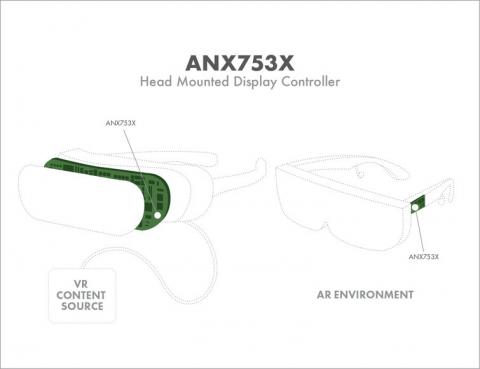"Analogix's ICVR Could Make VR HMDs Less Cumbersome"
by Fritz Nelson June 24, 2017 at 10:40 AM
Virtual reality activity at Computex earlier in June was sparse, with the usual assortment of “VR Ready” systems and components, but a small group consisting of Analogix Semiconductor, Dell, LG, and Tencent announced a potentially significant building block that went practically unnoticed. The group revealed ICVR, or "Interface for Connected VR," which is an attempt to standardize the physical connectivity of VR HMDs using DisplayPort over USB Type-C.
The key purveyor here is Analogix, a leader in DisplayPort technology. The company makes a variety of HDMI and DisplayPort transmitter and receiver cores, port controllers, and display controllers, and you’re likely making use of some of those on either (or both) a source device or display. The company’s DisplayPort timing controllers, for example, are in high-end notebook panels from LG, Samsung, Beijing Opto-Electronics, and Sharp, among others.

Earlier this year, the company created a series of mobile receivers (SlimPort DP to Quad MIPI-DSI display controllers) that let manufacturers use 120Hz displays in smartphones, mobile VR devices, and AR glasses, as well as 4K 60Hz panels in mobile devices.
Now the company is trying to position itself further in the world of VR. Clearly, ICVR stands to benefit Analogix, whose technology fits nicely within the confines of the proposed standard. The company’s architect also chairs a special interest group for VR and AR within VESA, so Analogix is making sure it’s a critical part of this developing ecosystem.
Using DisplayPort over USB Type-C will allow audio, video, head tracking data, and power to traverse a single cable between a VR headset and a VR source (PC or smartphone). Not only would a single cable reduce some of the clutter today’s high-end HMDs impose, but such a scheme would allow the elimination of transmitting radios and batteries from the headset, thereby allowing manufacturers to construct hardware that’s more lightweight and comfortable. Finally, the proposed effort would allow much more interoperability between VR source devices (smartphones and PCs) and HMDs that support the standard. Think Windows Mixed Reality running on commodity-like headsets from the usual suspects in the systems world.
Put differently, ICVR could be one crucial step in ushering in an XR ecosystem of commodity-like devices. Bluntly, it would allow the creation of mostly “dumb” VR headsets. Inherent in that is obviously cost reduction, which could also allow manufacturers to focus on improvements to the quality of the displays and the design of the HMDs.
Analogix claimed that it wouldn’t eliminate the high end of the market, where HTC Vive and Oculus Rift play. The company believes that there’s room for many different approaches, from those two particular companies at the high end to smartphone-powered experiences at the lower end. In between, we’ll also see solutions, like WiFi (and there are many players here, including Intel), which promises to eliminate cables altogether, but still keeps some of the complexity in the HMD (or adds to it if you consider the additional hardware required for WiFi transmission). Or we’ll see standalone HMDs, with everything including processors inside--we’ve seen demonstrations of this from Intel (Project Alloy) and Oculus (Santa Cruz).
Companies like Dell and Lenovo and Acer and other Wintel manufacturers have also made noise in the space that Analogix is targeting, and those are likely customers, along with--potentially--Asus and HP. In fact, Dell is behind the ICVR effort on the Windows side. LG is bringing Android to the party. Analogix projects between 2-4 million VR units shipping with its controllers inside, even before ICVR factors in.
With ICVR, Analogix will focus on a few key issues where DisplayPort is concerned, said Andre Bouwer, the company’s marketing chief. First, the video-out part of DP is not fully developed for VR, in that it cannot discover some of the capabilities of a headset related to field-of-view, panel persistence, and motion-to-photon latency. DisplayPort does include field of view discovery, Bouwer told us, but this is largely for things like size and pixel density, say for a TV, but it makes no assumption about how far away a user is, which is largely fixed with an HMD. Bouwer also said that DisplayPort must also have knowledge of the display scan mode, which differs among HMDs.
Another issue ICVR is tackling is head tracking. Although there will be other tracking issues over time, Bouwer said--like eye tracking and inside-out tracking, or even the specificity allowed by Lighthouse tracking--for now, the efforts will focus on the most basic, which is really understanding positioning and velocity of movement via gyro and accelerometer data. This is fairly simple data to add, he said.
There will be some additional protocols to ensure the source device is aware of the round-trip latency (motion to photon). This sort of synchronization is already a part of embedded DisplayPort (eDP), but that changes a bit in VR (obviously the latency is more crucial to comfort and factors in many other pieces of data than, say, a notebook) and must be accounted for.
Analogix told us that version 1.0 of the ICVR spec should be ready by the end of the year.
